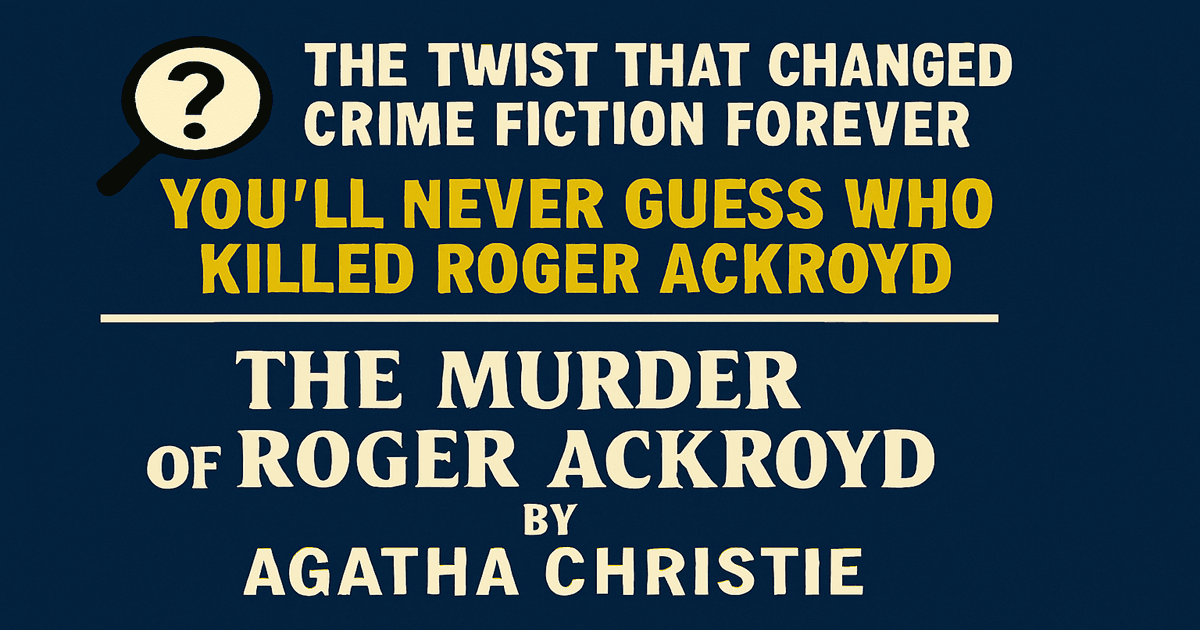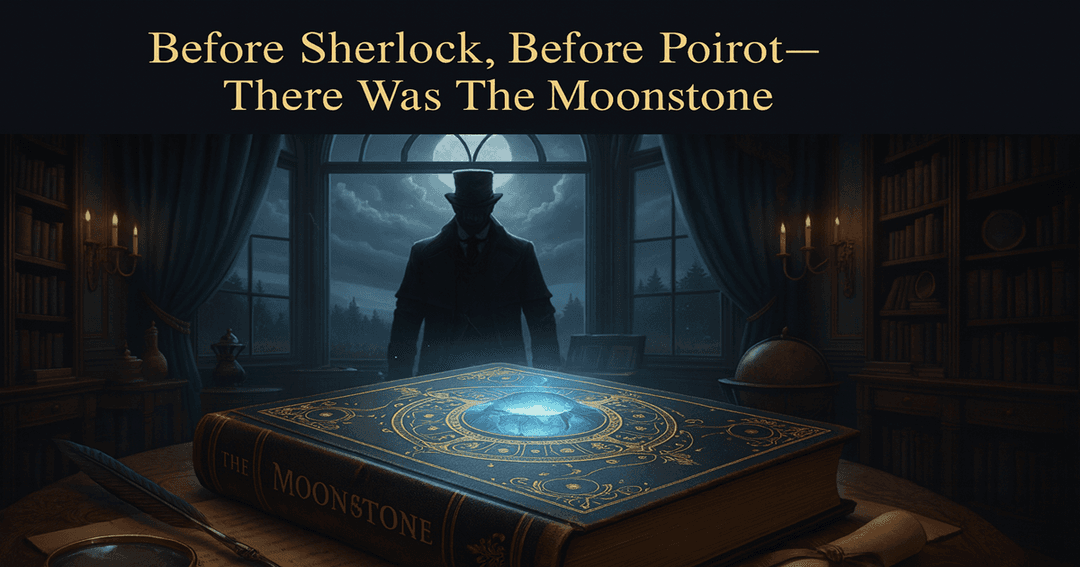What happens when the world's most famous mystery writer breaks every rule in the book? Literary chaos—and pure genius.
Imagine picking up a mystery novel, trusting the narrator completely, only to discover they've been lying to you for 300 pages. That's exactly what happened when Agatha Christie published "The Murder of Roger Ackroyd" in 1926, creating what many consider the greatest plot twist in literary history.
But here's the kicker: readers were so outraged, some demanded their money back.
Why The Murder of Roger Ackroyd Changed Everything
The Setup That Fooled Everyone
Roger Ackroyd, a wealthy widower, is found stabbed to death in his locked study. The suspects are classic Christie: the vanished stepson, the secretive niece, the suspicious butler. Everything screams "typical British mystery."
Enter Hercule Poirot, Christie's famous Belgian detective, supposedly retired and growing vegetables in the quiet village of King's Abbot. When murder disrupts his peaceful retirement, Poirot can't resist investigating.
The story unfolds through Dr. James Sheppard, the local physician who discovers the body and becomes Poirot's unofficial assistant. Sheppard documents every clue, every interview, every revelation with meticulous care.
Red flag alert: Why does a country doctor know everyone's deepest secrets?
The Twist That Broke Literary Rules
Here's where Christie pulled off the impossible. That trustworthy narrator who's been your guide through the entire mystery? Dr. Sheppard himself is the murderer.
The revelation sent shockwaves through the literary world. Critics accused Christie of cheating. How could readers solve a mystery when the storyteller was the criminal?
Why Critics Were Wrong (And Christie Was Brilliant)
Here's what Christie understood that her critics didn't: she never actually lied. Reread Dr. Sheppard's account knowing the truth, and you'll discover every statement is technically accurate. He just practices strategic omission.
When Sheppard writes he "left Ackroyd alive and well," he's telling the truth—Ackroyd was alive when Sheppard first left the room. That Sheppard returned minutes later to commit murder is simply information he chooses not to share.
The Murder of Roger Ackroyd's Lasting Impact
How One Book Revolutionized Mystery Fiction
Christie's controversial novel didn't just tell a story—it rewrote the entire genre:
Before 1926: Narrators were automatically trustworthy After 1926: Every narrator became suspect
Modern psychological thrillers like "Gone Girl" and "The Girl on the Train" trace their DNA directly to Christie's innovation. She created the template for the unreliable narrator that dominates contemporary fiction.
Critical Recognition Finally Arrives
In 2013, the British Crime Writers' Association voted "The Murder of Roger Ackroyd" the best crime novel ever written. This was stunning vindication for a book once considered literary blasphemy.
What changed wasn't the novel—it was our understanding of what mysteries could accomplish.
Why You Should Read The Murder of Roger Ackroyd Today
It's Still Shocking After 100 Years
Even knowing the twist, the novel delivers incredible satisfaction. Christie's technical mastery means every rereading reveals new layers of deception. The clues were always there—you just didn't know where to look.
It Created Modern Crime Fiction
Understanding "The Murder of Roger Ackroyd" is essential for any mystery fan. This single novel bridges the gap between classic detective fiction and contemporary psychological thrillers.
The Writing Is Simply Exceptional
Beyond its revolutionary plot, Christie's prose is elegant and precise. She creates vivid characters and atmospheric settings while maintaining perfect pacing throughout.
The Controversy That Made It Famous
Why Readers Felt Betrayed
The 1926 audience had clear expectations about mystery novels. Authors provided all necessary clues. Narrators told the truth. Solutions emerged from logical deduction.
Christie shattered these assumptions, making readers complicit in their own deception. The outrage was immediate and intense.
How Time Vindicated Christie's Vision
Nearly a century later, we recognize Christie's genius. She didn't break the rules of fair play—she exposed how limited those rules had become.
Modern readers appreciate unreliable narrators, but Christie invented the technique. Every psychological thriller owes debt to her audacious experiment.
Reading The Murder of Roger Ackroyd: What to Expect
The Characters You'll Love (And Suspect)
Dr. James Sheppard: Your narrator and guide (trust him at your peril)
Hercule Poirot: The famous detective in "retirement"
Roger Ackroyd: The victim with dangerous secrets
Flora Ackroyd: The niece with mysterious motives
Ralph Paton: The missing stepson everyone suspects
The Clues Hidden in Plain Sight
Christie plays absolutely fair. Every clue needed to solve the mystery appears in the text. The genius lies in how she presents information—technically truthful but strategically incomplete.
Watch for:
Sheppard's convenient presence at crucial moments
His intimate knowledge of village secrets
Carefully worded statements about his own actions
Timeline gaps that seem innocuous but aren't
Why The Murder of Roger Ackroyd Remains Relevant
It Predicted Our Disinformation Age
Christie's exploration of unreliable narration feels remarkably contemporary. In an era of fake news and manipulated information, her insights about trust and deception resonate powerfully.
It Elevated Genre Fiction
Before Christie, mystery novels were considered mere entertainment. "The Murder of Roger Ackroyd" proved genre fiction could achieve literary sophistication while remaining thoroughly entertaining.
It Changed How We Read
Once you've experienced Christie's narrative trick, you can never again trust a narrator completely. This healthy skepticism improves critical reading skills across all genres.
The Verdict: Masterpiece or Cheat?
Nearly 100 years of debate have reached a clear conclusion: "The Murder of Roger Ackroyd" is Christie's masterpiece and one of literature's greatest achievements.
The novel succeeds because it respects readers' intelligence while proving that even sophisticated audiences can be fooled by their own assumptions. It's not about the destination—it's about realizing you were never on the journey you thought you were taking.
Ready to Experience Literary History?
"The Murder of Roger Ackroyd" remains as shocking today as in 1926. Whether you're a mystery veteran or newcomer to Christie's work, this novel delivers an unforgettable reading experience.
Fair warning: once you've read it, you'll want to immediately start over. The second reading is completely different from the first—and equally satisfying.
Christie didn't just write a mystery. She wrote THE mystery that redefined what mysteries could be. Don't just read about literary history—experience it yourself.
Have you read "The Murder of Roger Ackroyd"? What was your reaction to the famous twist? Share your thoughts in the comments below.


